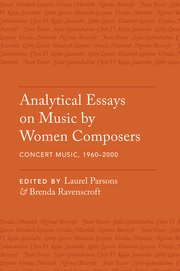
OXFORD UNIVERSITY PRESS - 19
Analytical Essays on Music by Women Composers
Editors: Brenda Ravenscroft, Laurel Parsons
Analytical Essays on Music by Women Composers
Juilliard Store
144 West 66th Street
New York NY 10023
United States
Choose options
Analytical Essays on Music by Women Composers
Juilliard Store
144 West 66th Street
New York NY 10023
United States
Analytical Essays on Music by Women Composers
Juilliard Store
144 West 66th Street
New York NY 10023
United States
Edited by Laurel Parsons and Brenda Ravenscroft
Over the past 30 years, musicologists have produced a remarkable new body of research literature focusing on the lives and careers of women composers in their socio-historical contexts. But detailed analysis and discussion of the works created by these composers are still extremely rare. This is particularly true in the domain of music theory, where scholarly work continues to focus almost exclusively on male composers. Moreover, while the number of performances, broadcasts, and recordings of music by women has unquestionably grown, these works remain significantly underrepresented in comparison to music by male composers. Addressing these deficits is not simply a matter of rectifying a scholarly gender imbalance: the lack of knowledge surrounding the music of female composers means that scholars, performers, and the general public remain unfamiliar with a large body of exciting repertoire.
Analytical Essays on Music by Women Composers: Concert Music, 1960-2000 is the first to appear in a groundbreaking four-volume series devoted to compositions by women across Western art music history. Each chapter opens with a brief biographical sketch of the composer before presenting an in-depth critical-analytic exploration of a single representative composition, linking analytical observations with questions of meaning and sociohistorical context. Chapters are grouped thematically by analytical approach into three sections, each of which places the analytical methods used in the essays that follow into the context of late twentieth-century ideas and trends. Featuring rich analyses and critical discussions, many by leading music theorists in the field, this collection brings to the fore repertoire from a range of important composers, thereby enabling further exploration by scholars, teachers, performers, and listeners.
Table of Contents:
Acknowledgments
About the Companion Website
Chapter 1. Introduction
Laurel Parsons and Brenda Ravenscroft
PART I
Order, Freedom and Design
Chapter 2. Ursula Mamlok, Panta Rhei, Third Movement (1981)
"Twelve Tone in My Own Way": An Analytical Study of Ursula Mamlok's Panta Rhei, Third Movement, with Some Reflections on Twelve-Tone Music in America
Joseph N. Straus
Chapter 3. Norma Beecroft, Improvvisazioni Concertanti No. 1 (1961)
Improvvisazioni Concertanti No. 1 by Norma Beecroft: Serialism, Improvisatory Discourse, and the Musical Avant-Garde
Christoph Neidhöfer
Chapter 4. Joan Tower, Silver Ladders (1986)
"Octatonicism," the Octatonic Scale, and Large- Scale Structure in Joan Tower's Silver Ladders
Jonathan W. Bernard
PART II
Gesture, Identity and Culture
Chapter 5. Sofia Gubaidulina, String Quartet No. 2 (1987)
"Difference Inhabits Repetition": Sofia Gubaidulina's String Quartet No. 2
Judy Lochhead
Chapter 6. Chen Yi, Symphony No. 2 (1993)
The Transformative Power of Musical Gestures: Cultural Translation in Chen Yi's Symphony No. 2
Nancy Yunhwa Rao
PART III
Music, Words and Voices
Chapter 7. Kaija Saariaho, "The claw of the magnolia..." From the Grammar of Dreams (1988)
Superposition in Kaija Saariaho's "The claw of the magnolia..."
John Roeder
Chapter 8. Libby Larsen, Chanting to Paradise (1997)
Music as a Mirror: Libby Larsen's Chanting to Paradise
Brenda Ravenscroft
Chapter 9. Elisabeth Lutyens, Essence of Our Happinesses (1968)
This Imaginary Halfe-Nothing: Temporality in Elisabeth Lutyens's Essence of Our Happinesses
Laurel Parsons
Glossary
Bibliography
Index
